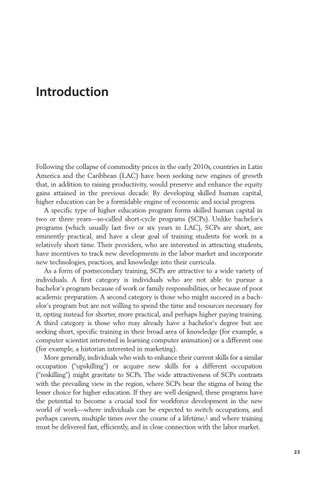Introduction
Following the collapse of commodity prices in the early 2010s, countries in Latin America and the Caribbean (LAC) have been seeking new engines of growth that, in addition to raising productivity, would preserve and enhance the equity gains attained in the previous decade. By developing skilled human capital, higher education can be a formidable engine of economic and social progress. A specific type of higher education program forms skilled human capital in two or three years—so-called short-cycle programs (SCPs). Unlike bachelor’s programs (which usually last five or six years in LAC), SCPs are short, are eminently practical, and have a clear goal of training students for work in a relatively short time. Their providers, who are interested in attracting students, have incentives to track new developments in the labor market and incorporate new technologies, practices, and knowledge into their curricula. As a form of postsecondary training, SCPs are attractive to a wide variety of individuals. A first category is individuals who are not able to pursue a bachelor’s program because of work or family responsibilities, or because of poor academic preparation. A second category is those who might succeed in a bachelor’s program but are not willing to spend the time and resources necessary for it, opting instead for shorter, more practical, and perhaps higher paying training. A third category is those who may already have a bachelor’s degree but are seeking short, specific training in their broad area of knowledge (for example, a computer scientist interested in learning computer animation) or a different one (for example, a historian interested in marketing). More generally, individuals who wish to enhance their current skills for a similar occupation (“upskilling”) or acquire new skills for a different occupation (“reskilling”) might gravitate to SCPs. The wide attractiveness of SCPs contrasts with the prevailing view in the region, where SCPs bear the stigma of being the lesser choice for higher education. If they are well designed, these programs have the potential to become a crucial tool for workforce development in the new world of work—where individuals can be expected to switch occupations, and perhaps careers, multiple times over the course of a lifetime,1 and where training must be delivered fast, efficiently, and in close connection with the labor market.
23

